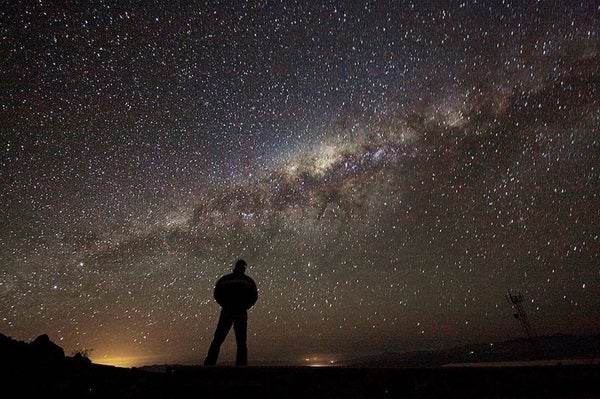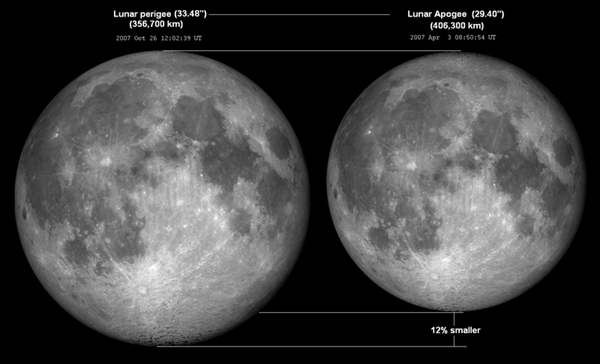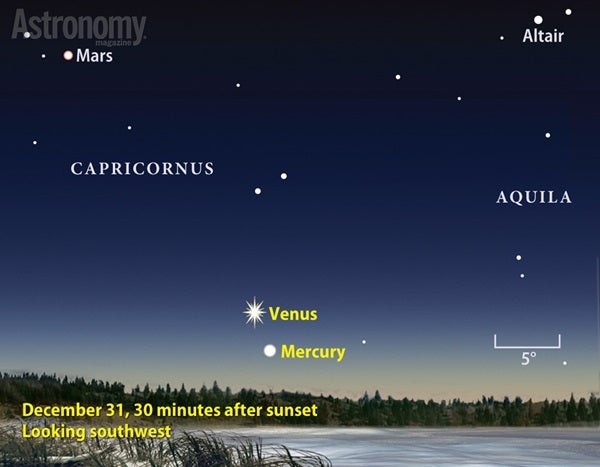The waxing gibbous Moon lies just east of the 1st-magnitude star Aldebaran this evening. (Our satellite reached First Quarter phase at 3:09 a.m. EST today.) Depending on where in North America you live, the gap appears to be 4° or 5° in early evening and grows about 0.5° every hour thereafter. Aldebaran represents the eye of Taurus the Bull and appears to mark one tip of the V-shaped Hyades star cluster. In reality, Aldebaran lies only about half as far from Earth as the cluster does.
Saturday, February 24
Mars rises shortly after 2 a.m. local time and appears 25° high as twilight starts to paint the sky. The magnitude 0.9 Red Planet lies against the backdrop of southern Ophiuchus, and this morning has a close encounter with the 9th-magnitude globular star cluster NGC 6287. Astroimagers will want to capture the planet as it passes just 15′ north of the cluster. Unfortunately, the view of Mars through a telescope proves disappointing — its disk spans only 6″ and shows no detail.
Sunday, February 25
The dwarf planet Ceres reached opposition and peak visibility in late January, and it remains a fine sight this month. It currently shines at magnitude 7.3 and is an easy object to spot through binoculars. The largest member of the asteroid belt resides in the northern part of the constellation Cancer the Crab, which appears in the east once darkness falls and climbs nearly overhead around 10 p.m. local time. This evening, Ceres lies 0.8° southwest of the magnitude 5.7 star Sigma1 (σ1) Cancri.
Monday, February 26
Head outside before dawn and you can’t miss Jupiter. The giant planet rises around midnight local time and climbs highest in the south as twilight commences. Jupiter shines at magnitude –2.1, which makes it the brightest point of light in the morning sky, and resides among the much dimmer stars of the constellation Libra. A telescope reveals the planet’s 39″-diameter disk.
Tuesday, February 27
The variable star Algol in Perseus reaches minimum brightness at 6:54 p.m. EST, when it shines at magnitude 3.4. If you start viewing as soon as darkness falls, you can watch it more than triple in brightness (to magnitude 2.1) over the course of about five hours. This eclipsing binary star runs through a cycle from minimum to maximum and back every 2.87 days. Algol appears high in the west after sunset and sinks slowly toward the northwestern horizon after midnight.
The Moon reaches perigee, the closest point in its orbit around Earth, at 9:39 a.m. EST. It then lies 226,137 miles (363,932 kilometers) away from us.
Saturn rises more than three hours before the Sun and climbs some 15° high in the southeast by the time morning twilight begins. The ringed planet shines at magnitude 0.6 among the fainter background stars of Sagittarius the Archer. When viewed through a telescope, Saturn shows a 16″-diameter disk surrounded by a stunning ring system that spans 36″ and tilts 26° to our line of sight.
Thursday, March 1
Full Moon arrives officially at 7:51 p.m. EST, but it looks completely illuminated all night. You can find it rising in the east at sunset and peaking in the south just after midnight local time. It dips low in the west by the time morning twilight begins. The Moon spends the night among the background stars of southern Leo the Lion.
Friday, March 2
This is a good week to look for Sirius in the evening sky. The night sky’s brightest star (at magnitude –1.5) appears highest in the south shortly after twilight ends. It then lies about one-third of the way from the horizon to the zenith when viewed from mid-northern latitudes. (The farther south you live, the higher it appears.) If you point binoculars at Sirius, look for the pretty star cluster M41 in the same field, just 4° below the star.
After a long hiatus, both Mercury and Venus return to the evening sky in early March. The two neighbors lie low in the west during twilight and show up nicely through binoculars. Venus shines at magnitude –3.9 and stands 5° high a half-hour after sunset. Although Mercury appears just one-tenth as brilliant, at magnitude –1.2, that’s still bright enough to see if you have a clear and unobstructed horizon. This evening, Mercury lies just 1.1° to Venus’ right, their closest approach during 2018.
Sunday, March 4
March evenings offer an excellent chance to see the zodiacal light. From the Northern Hemisphere, late winter and early spring are great times to observe this elusive glow after sunset. It appears slightly fainter than the Milky Way, so you’ll need a clear moonless sky and an observing site located far from the city. With the waning gibbous Moon now exiting the early evening sky, this is the time to seek out the light (excellent conditions continue through March 18). Look for the cone-shaped glow, which has a broad base and points nearly straight up from the western horizon, after the last vestiges of twilight have faded away.
Neptune is in conjunction with the Sun at 9 a.m. EST. The distant planet is hopelessly lost in the solar glare but will return to view before dawn in April.












